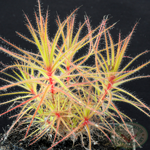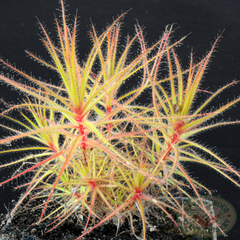
Growing Tips for Roridula



Growing Tips for Roridula
Roridula - Roridula gorgonias and R. dentata.
Soil: 1:1 coarse sand:peat mix
Container: 4+" plastic pot
Watering: moist, not wet, drier in winter
Light: full to part sun
Temperature: moderate year round
Humidity: medium
Location: windowsill, terrarium, greenhouse, outdoors
Dormancy: no, prefers cool, dry winter.
Habitat
The Flycatcher Bush, Roridula, grows naturally in the peat and sandy bogs of the Cape Provinces of South Africa. This is a mediterranean climate with dry summers and cool, wet winters. The plants can tolerate a light frost or a brief heatwave. The coarse soils are peaty and consistently moist bogs of sphagnum peat and are often inundated with coastal fog.
Culture
Roridula can be challenging to grow. Keep in mind it comes from a mediterranean-like climate, much like that of Cephalotus, and prefers humid, warm, sunny conditions, i.e. subtropical. For Winter, keep cooler, but not cold winter temperatures with soil slightly drier soil, and remember roots are prone to rot when kept wet in Winter. Use a coarse, peaty soil mix 1:1. The tray method works well, standing in about 1/4" of water. Roridula benefits from light foliar fertilizer.
Dormancy
Roridula are subtropical plants from mediterranean climates and do not need a dormancy period. However, a slightly drier, cooler winter benefits spring growth. Roridula can tolerate light frost and brief temperatures as low as 22°F (-5°C).
Feeding
Roridula are subcarnivorous and rely on the droppings of captured prey and symbotic assassin bugs to supplement their nutritional needs. Feeding with wingless fruitflies is beneficial. During the active growth of Spring and Summer a dilute foliar fertilizer may be used.
Other Considerations
Roridula seeds need light to germinate, but can be dry stored for several years. Best sown in Spring, and benefit from smoke treatment.
Avoid water droplets on the leaves which promote discoloration and die back.
Propagate from seed, as cuttings only rarely take root.
Roridula is very popular and in high demand by hobbyists. Because it is slow to grow and difficult to propagate, it is often very expensive compared to other carnivorous plants.
